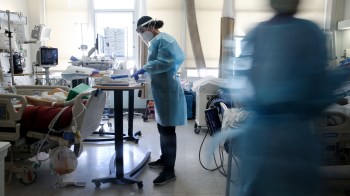
Home care experiment could mean fewer hospital stays

There’s a little $10 million health care experiment going on in New York that could mean fewer of us will end up in the hospital.
In the past year and a half, Mt. Sinai Hospital has started treating a number of patients at home, and early signs suggest this improves care, lowers spending and leaves patients more content. The stakes are high.
If this project goes well, hospital at home could soon be popping up around the country.
Mt. Sinai has been working with about 200 patients — often fragile people, like 82-year-old Alicia Perez, who suffers from high blood pressure, diabetes, hypertension and vision problems.
A few weeks back, Perez went to the hospital’s emergency room to get treatment for a urinary tract infection. Typically, someone like Perez goes from the ER to the hospital, often as a precaution. But it’s a precaution that costs $8,500 for admission and treatment at Mt. Sinai.
Instead, Perez opted to get treated by Mt. Sinai staff in her Upper West Side high-rise apartment for about $1,500 less.
“I have lots of people from this team come to my home. They even gave me IV fluids, and they’ve been checking my blood pressure, my pulse,” Perez said.
For 20 years, a few hospitals and Veterans Affairs have offered a hospital-at-home program. It’s designed for people who have a solid diagnosis, like pneumonia, dehydration or congestive heart failure. Studies have shown patients are 19 percent more likely to be alive six months after receiving at-home treatment.
Mt. Sinai’s Dr. Al Siu said the promise here is obvious.
“We’ve known we can do this. We can do it safely,” he said. “That patients have fewer complications, that patients like it and are satisfied. But we haven’t been able to disseminate this because there’s no way of paying for this.”
Halfway through the three-year project, Mt. Sinai’s data suggest the hospital is saving money and cutting readmissions.
Medicare is watching closely, and sustained stats like that will certainly get its attention.
But Karrie Decker, who runs a hospital at-home program for Presbyterian Healthcare Services in New Mexico, said replicating this work is tricky.
“Somebody is putting a shingle up that they do hospital at home, and yet when things start to go sideways, or a patients starts to have a problem, they don’t end up being available to that patient,” she said.
In other words, hospital-at-home programs raise safety and fraud prevention challenges.
When it works, Alicia Perez said it’s the kind of care we all want.
“Being at home, you can save way more money. You are going to be more comfortable, and you are going to be well taken care of,” she said. “The hospital may be magnificent, but the home is way better.”
There’s a lot happening in the world. Through it all, Marketplace is here for you.
You rely on Marketplace to break down the world’s events and tell you how it affects you in a fact-based, approachable way. We rely on your financial support to keep making that possible.
Your donation today powers the independent journalism that you rely on. For just $5/month, you can help sustain Marketplace so we can keep reporting on the things that matter to you.


















